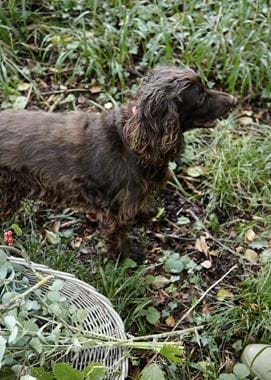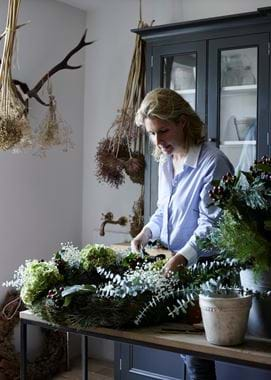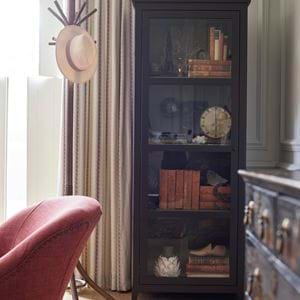Talking to Hannah Redman
Talking to Hannah Redman
It’s a lovely coincidence that when you need to speak to an expert on a certain topic, it turns out exactly what you’re looking for is right in front of you. That’s what happened when we wanted to offer our flower-arranging tips. The wife of one of our founders Giles, is a self-taught floristry whiz, and so our search ended before it had really begun.
Hannah. In brief
Hannah. Is effortlessly put together. From clothes to home, she channels an easy kind of elegance that’s relaxed and approachable. She’s constantly followed by the pitter-patter sound of paws. Their chocolate working cocker spaniel, Mocha, is always two steps behind her.
On flowers. Is somewhat of a natural. When asked what her number one tip would be on arranging she replied, “Just go with it. You’re not meant to think.”
On family. Mum to Olivia, Bella, Max and Charlie whose ages range from seven to thirteen. Her parents live in the same village too. And, there’s talk of a second dog. It’s a busy house.
First, we asked how Hannah got into flowers.
I was so fed up with buying fresh flowers and them dying within a week, max. So I started planting bulbs in baskets and porcelain pots and selling them at the Christmas fairs. I loved it but it was too much with the children and it was getting to the point that I needed a helping hand. I needed a way to make flowers part of my life but in a way that worked with my lifestyle. So I started planting.
She showed us what she meant.
I’ve created a few zones in our garden but the cutting garden and vegetable patch is where the magic happens. We try to be as home-grown as possible, so we grow all our flowers and our own organic vegetables and fruit, from redcurrants and strawberries through to squash and sweet peas; the germinating and the eating are the most fun parts! The cutting garden is where I grow the flowers that I’ll want to bring inside. It’s a way of celebrating flowers indoors without spoiling the beauty of having flowers in the garden too. It’s so exciting to watch the bulbs grow up in the garden. It means spring is on the way.
I fill our home with bulbs and, when the flowers die, I replant them in the main garden so they can bloom for a second time next year, though a little more softly. And if I ever buy plants for inside, I’ll only buy them if I know they can go in the garden flowerbeds afterwards. They must be recyclable.
We wanted to know what Hannah’s favourite seasonal flowers were...
For spring, the daffodil ‘Bridal Crown’, grape hyacinths and tulips. For summer, dahlias and anything from my cutting garden, like alliums and foxgloves. For autumn, whatever the garden has left to offer, like chrysanthemums and amaryllis. For Christmas, paper whites. And for all year round, hydrangeas.
...and, importantly, how she learnt so much.
Have you heard of Sarah Raven? She’s one of the most successful garden ladies in Britain, and so I’ve spent a great deal of time reading her books and her column. Then there’s my mother who always had amazing flowers in the home.
She shared some of her tips for bringing flowers into everyday life.
A garden table can be elevated with a basket of flowers in the centre. Flowers in the bathroom are such a luxury so I choose geraniums with their rich leaves and love for warmth and moisture. Tulips are great in a bathroom too, but generally I think they work better downstairs. Flowers as a centrepiece on an indoor dining table is something we all know, but I like to change the way I do it every time we have guests. I don’t think a centrepiece has to always be just one big vase. We had friends over at the weekend and I did a long line of vintage glass bottles with five stems of long, tall tulips inside. Another time I did reclaimed terracotta pots with trailing grape hyacinths and moss spilling out. There’s so much you can do. Oh, and I love to place Nemesia ‘Vanilla Lady’ by the back doors so you smell it as soon as you come inside.
Onto flower-arranging.
Firstly, colour. You need to think not just about what colours you like, but ones that your room will like too. Next I think about seasonality – using flowers that are true to the season you’re in. This is a lovely thing to consider with life-like flowers too. Greenery is hugely important. I like eucalyptus, euphorbia and artichoke leaves, and soft moss in pots. Flowers, real or life-like, need foliage. Height. Varying height makes your arrangement feel much more natural; it gives the bunch flow. Finally, what you choose to display your flowers in (or plants, for that matter) will completely transform your piece. Big vases are fantastic, but what I love the most are dramatic urns that I pick up from antiques markets. Our house is filled with them. They’re just a little unexpected.
And when you’re doing a bouquet, always lay your flowers flat on a surface, but at an angle so they naturally fan out. Never do them straight. Alternatively, hold the bunch in your hand and gradually add to it, piece by piece, feeding the bouquet as you go. Whichever way you feel most comfortable with.
And the future?
I’d love to work with flowers in a more creative way again, I really would. We’ll see. For now, knowing that I’m creating a home that’s warm from the moment you come in is enough. My children’s paintings, crumbling urns of home-grown flowers everywhere, meals cooked with ingredients grown in our own soil, they all welcome people in, and that’s what I really want.













